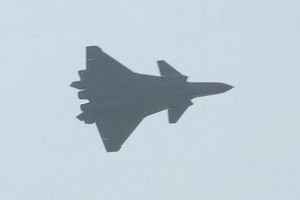The People’s Liberation Army Air Force’s (PLAAF) new fifth-generation fighter aircraft, the Chengdu Aerospace Corporation (CAC) J-20A multirole fighter, has participated in its first air combat exercise in early January, according to a PLAAF news release.
The air combat exercise took place at an undisclosed air base in China this month and lasted nine days. It involved beyond-visual-range aerial fighting maneuvers against Shenyang J-16 fighter-bombers and Chengdu J-10 multirole fighter aircraft.
The exercise also involved Xian H-6K long-range bombers.
This is the first time that the PLAAF has publicly confirmed that the J-20A has participated in combat training. It is unclear how many J-20A fighter jets were involved in the drill. However, this is not the first exercise of its kind for the new stealth fighter.
The military channel of China Central Television (CCTV) showed video footage of J-20s flying alongside H-6K long-range bombers and Xian Y-20 large military transport aircraft in March 2017. The television report stated that the J-20A participated in a number of exercises with People’s Liberation Army (PLA) units.
The J-20A is a twin-engine single-seat fifth-generation (designated fourth-generation in the PLAAF) stealth fighter, built by Chengdu Aerospace Corporation. The aircraft, which took to the skies for the first time in January 2011, is designed for long-range fighter missions such as attacking enemy support aircraft including tankers with PL-12 beyond visual range air-to-air missiles.
In September 2017, a spokesperson for the Chinese Ministry of National Defense confirmed at a news conference that the J-20A has been officially commissioned into military service. There is speculation that the aircraft has already entered serial production, although it remains unclear whether the aircraft has already achieved full operational capability.
The J-20 still lacks an indigenously developed and designed next-generation high performance turbofan jet engine and continues to rely on Russian-made jet engines. As I reported in October 2017:
The domestically developed WS-15 turbofan engine, a thrust engine under development since the 1990s, has not entered serial production. It is assumed that the first patch of J-20s is equipped with an unknown variant of the Saturn AL-31, an older Russian-made jet engine. According to some sources, the J-20 is still purportedly incapable of super cruising — sustained supersonic flight.
“There are still a series of technical problems that need to be tackled [on the J-20], including the reliability of its WS-15 engines, [and the plane’s] control system, stealth coat and hull materials and infrared sensor,” a Chinese military official told the South China Morning Post in March 2017.
“It is (…) unclear whether the J-20 can match the radar-evading capabilities of the Lockheed Martin F-22 Raptor stealth fighter aircraft or the F-35 Lightning II fighter,” I explained previously. “Given that the aircraft apparently lacks thrust vectoring, it is likely less maneuverable than American-made fifth-generation warplanes.”
According to previous estimates, the PLAAF currently operates eight J-20As prototypes and five low rate initial production fighter jets.































